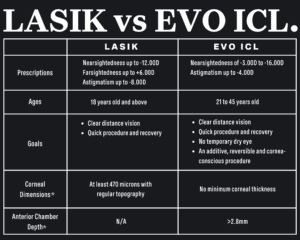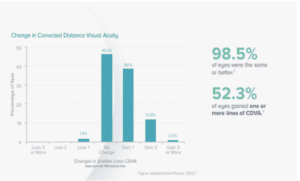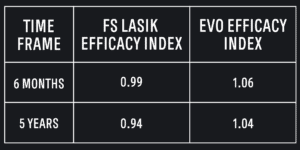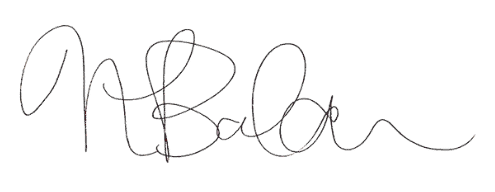Navigating Vision Correction: LASIK vs. EVO ICL for Long Term Clarity


November 27, 2023
Vision is an irreplaceable treasure, and we know the quest for clear sight through glasses and contact lenses can be an ongoing journey for a lot of our patients. With myopia affecting a substantial and growing portion of the global population (an estimated 50% by 2050), the demand for effective, long-term vision correction methods is widespread. Refractive surgeries like LASIK and the EVO ICL (Implantable Collamer Lens) can offer an incredible transformation for those relying on glasses and contacts to correct myopia and astigmatism.
Let’s start with the basics. Who are these procedures for and how do I know which one is right for me?

*We use Galilei scans to capture the 3D shape and thickness of your cornea and the depth of your anterior chamber. One of our doctors will share your results with you as part of your consultation.
LASIK
Is LASIK right for you? In most cases, yes! While not everyone can safely have laser vision correction, more than 80% of the patients we see are great candidates for LASIK. LASIK has been around since the mid 1990’s, and it’s a tried and true method of vision correction, successfully delivering clear vision for millions of patients. We use an extremely precise femtosecond laser to create the flap and an excimer laser to create a custom, perfectly aspheric corneal surface.
EVO ICL
If you are 21 or older and nearsighted, you could be a candidate for EVO ICL. This procedure is able to correct or reduce 3 to 20D of myopia and up to 4D of astigmatism. It’s especially beneficial for those with thin corneas, dry eyes, or who otherwise do not qualify for LASIK. EVO works in harmony with your natural eye, similar to adding a lens to a camera. It’s made from a collagen-containing biocompatible material called collamer that also provides UV protection. The V4c EVO+ has a 0.36mm central port for added safety and aqueous flow and an expanded optic designed to optimize night vision. ICL technology has been used for more than 20 years and is the fastest growing refractive procedure today. To date, more than 2 million ICLs have been distributed worldwide.
Occasionally patients are candidates for both LASIK and EVO. While it’s a privilege to have a choice between more than one procedure, we understand it can be tricky to navigate the best surgical option. Here we’ll dive into a few key factors that help guide these decisions: safety and efficacy, stability i.e. vision outcomes in the short and long term, and personal preferences.
How do LASIK and EVO ICL stack up?
Patients who undergo LASIK or EVO can look forward to significant improvements in their lifestyle, a rapid recovery and to safely achieving 20/20 vision or better after their procedure. When comparing the two, it’s a close call, but a few studies have concluded favorable vision outcomes and stability with EVO compared to LASIK.

Better than before… and better than 20/20? The EVO FDA Clinical trial showed 52.3% of eyes measuring -3.00 to -15.62D treated with ICL actually gained one line of vision. In fact, this percentage was a bit higher at 56% when filtering for mid-range prescriptions of -3.00 to -6.00D. Another clinical review comparing the outcomes of 1678 LASIK treated eyes and 144 treated ICL eyes in a similar range (-4.00 to -7.88D) found a greater proportion of ICL eyes read 20/15 or better (21.6% ICL vs. 7.8% LASIK, P < 0.001).
Why might this be?
Optical corrections that more closely align with the nodal point of the eye nodal point (N) of the eye hold the potential to optimize vision more effectively. This is why some patients see better with contacts as compared to their glasses. The same concept holds true when comparing ICL with LASIK, contact lenses or glasses.
Will my vision drift after LASIK? How about EVO ICL?
Many patients want to know “how long will my procedure last”? While LASIK is a permanent procedure that irreversibly removes tissue from the corneal stroma, changes over time are possible. At SharpeVision, we’ve tracked the enhancement rate of LASIK somewhere between 2-5% in the first year, and roughly 10% over a 10 year period. Age, treatment zone, corneal dimensions, bladed vs femtosecond laser (FS) flap creation, hormone shifts, and the degree of myopia have all been cited as predictive factors that can influence postoperative regression. Regression refers to the possibility that the eye gradually becomes out of focus again and may require glasses or additional laser touch up. Though LASIK enhancements can be done safely and effectively by lifting the corneal flap or performing additional surface laser (PRK), we find, whenever possible, one procedure is better than two. This principle will often guide our doctors’ recommendations for you.
Regression rates following LASIK are reported variably between 10 and 50%. Though the research shows a large delta – likely due to difference in study design, number of participants, and varying timeline- the research is consistent in that higher rates of regression are found to be universally well-correlated with higher prescriptions, around -7.00 and up. Because of this, and bearing in mind that the larger the prescription, the more tissue is removed with LASIK or PRK, most patients with prescriptions greater than -7.00D are often better suited for ICL. After ICL, the chance of needing an enhancement is far less likely, generally less than 1%.
Efficacy indices over time
An efficacy index is a measure of how well something works or how effective it is at achieving its intended goal. It’s a way to express the efficiency or success of a particular process, product, or system. The higher the efficacy index, the more successful or efficient the thing being measured is considered to be. It’s a way to quantify how well something does what it’s supposed to do. When applied to eye surgery, the efficacy index is the uncorrected post-operative visual acuity (measured vision after surgery) divided by the pre-operative corrected visual acuity (measured vision before surgery with glasses or contacts). How do these numbers compare for LASIK and EVO ICL?

This table compares the efficacy indices of FS LASIK and ICL procedures over a 6-month and 5-year time span using FDA and pooled data from multiple studies (retrospective comparative reviews). Though both procedures are remarkably efficacious, the indices hint at the potential for a more refined, accurate and stable outcome with EVO ICL.
The decision between LASIK and ICL depends on a myriad of factors, and on occasion, our doctors may recommend or patients may opt for LASIK over ICL for several reasons:
- A preference toward the non-invasive nature of LASIK, as it does not involve placing an implant in the eye.
- Time commitment: Length of procedure (LASIK takes 5-10 minutes and EVO ICL takes 20-30 minutes) and number of follow ups (2 vs 4 appointments).
- Familiarity
- Insurance or cost considerations
- Medical reasons – inadequate anterior chamber space, endothelial cell count, or a history of glaucoma.
The Takeaway
LASIK and EVO ICL are exceptionally safe and produce reliably great vision for those patients who are good candidates. In fact, procedures like EVO ICL and LASIK not only liberate patients from glasses and contacts, but they also have the potential to enhance their vision beyond what they experienced before undergoing surgery. For some patients, ICL may be a more favorable choice, and for others, we stick with LASIK. Our doctors are here to support you regardless of your choice. Keep in mind the suitability of these procedures can vary among individuals, and consulting with an eye care professional is necessary for personalized advice.
References
- Alfonso JF, et al. Five-year follow up of correction of myopia: posterior chamber phakic intraocular lens with a central port design. Journal of Refractive Surgery 2019; 35: 169-176.
- Castro-Luna G, et al. Long Term Follow-Up Safety and Effectiveness of Myopia Refractive Surgery. Int J Environ Res Public Health. 2020;17(23):8729.
- Kamiya K, et al. Posterior chamber phakic intraocular lens implantation: comparative, multicentre study in 351 eyes with low-to-moderate or high myopia. Br J Ophthalmol. 2018;102(2):177-81.
- Mont es-Mic o R. Posterior-chamber phakic implantable collamer lenses with a central port: a review. Acta Ophthalmol. 2021: 99: e288–e301
- Packer M. Evaluation of the EVO/EVO+ Sphere and Toric Visian ICL: Six month results from the United States Food and Drug Administration clinical trial. Clinical Ophthalmology. 2022;16:1541-53.
- Sanders D, Vukich JA. Comparison of implantable collamer lens (ICL) and laser-assisted in situ keratomileusis (LASIK) for low myopia. Cornea. 2006;25(10):1139-1146.

Dr. Natasha Balani
